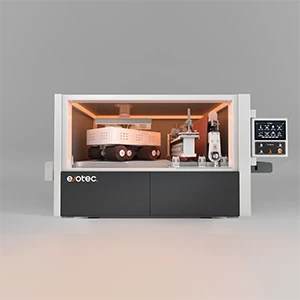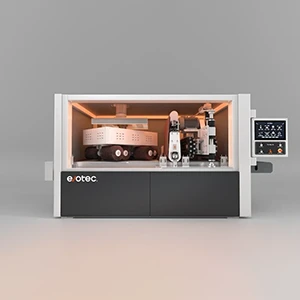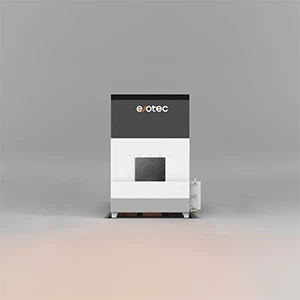Why Wet Extraction Systems Are the Smart Choice for Modern Metal Finishing Lines
Metal finishing may look clean on the surface, but beneath every sanding belt and rotary brush lies an invisible hazard—metal dust. When processing stainless steel, aluminum, or other non-ferrous materials, these fine particles can become explosive if left airborne or trapped in dry filters. Modern manufacturing demands a safer and more efficient approach. Evotec’s HydroDust 2.0 Wet Extraction System tackles this challenge by using water as the filtration medium, neutralizing sparks, and maintaining 99% capture efficiency—creating cleaner air and safer workshops without sacrificing performance.

Key Takeaways
- Eliminates Fire and Explosion Risks
Neutralizes combustible metallic dust at the source through a controlled water-scrubbing process. - Delivers Stable, High-Efficiency Filtration
Maintains consistent suction and over 99% removal efficiency—even under heavy load—without filter clogging or costly media replacements. - Integrates Seamlessly with Evotec Machines
Fully compatible with Surfex SRS, EdgeX SDR, SlagMaster HSR, and FabGo 300, synchronizing with EvoFlow conveyors and GuardianSense monitoring. - Reduces Maintenance and Operating Costs
Water-based filtration requires minimal upkeep, lowers energy consumption, and extends abrasive lifespan by keeping the work environment dust-free. - Supports a Cleaner, More Sustainable Workplace
Closed-loop water filtration minimizes waste while ensuring air quality well below international exposure limits.
The Hidden Hazard in Metal Finishing
Every grinding, deburring, or surface-finishing process produces fine metallic dust. In dry systems, these particles—especially from aluminum, stainless steel, or magnesium—can oxidize and ignite under the right conditions. Traditional cartridge or bag filters capture dust but also accumulate combustible residues, turning a simple filtration task into a fire or explosion risk.
As production speeds rise and abrasive technology advances, dust loading per minute increases. The modern answer to this challenge is wet extraction, which neutralizes combustible particles by trapping them in a controlled water medium before they can ignite.
How Wet Extraction Works
A Wet Extraction System (WES) uses water as both a scrubbing and separation medium. In Evotec’s HydroDust 2.0, the process unfolds in several aerodynamic stages:
- Intake and Impact:
Dust-laden air is drawn into the chamber by a high-pressure fan and directed toward the water surface, where heavy particles instantly lose kinetic energy and sink. - Turbulent Mixing:
The airstream then passes through an S-shaped impeller path, accelerating airflow and agitating the water. This generates a dense mist of micro-bubbles that entrap fine particulates. - Centrifugal Separation:
The rapid directional change induces a centrifugal force, pushing heavier matter toward the chamber wall where it combines with moisture and settles. - Mist Elimination:
The cleaned air then enters a demisting section with baffle plates that strip residual droplets. The condensate returns to the tank, while purified air exits through the exhaust duct.
This closed-loop process removes up to 99% of airborne metallic dust, maintaining consistent airflow without relying on disposable filters. The collected slurry is periodically drained or automatically discharged, keeping maintenance predictable and safe.
Why Wet Extraction Outperforms Dry Filtration

Integration with Evotec Finishing Systems
Evotec’s wet extraction technology is designed as a modular add-on across our finishing platforms:
- Surfex SRS – Line-grain finishing with integrated HydroDust 2.0 ensures stable airflow and clean linear textures, ideal for stainless or architectural surfaces.
- EdgeX SDR – R2+ edge rounding and non-directional finishing benefit from consistent suction and spark-free operation.
- SlagMaster HSR – Heavy slag and burr removal produces significant particle volumes; coupling with HydroDust 2.0 prevents abrasive belt contamination and airborne hazard.
- FabGo 300 – Compact lines can utilize smaller-capacity wet collectors for entry-scale fabrication environments.
The HydroDust 2.0 connects directly to each machine’s extraction port via the EvoFlow® conveyor system, ensuring synchronized dust removal as parts pass through deburring, brushing, or sanding stages. Integrated GuardianSense Maintenance sensors monitor airflow pressure and water level, automatically alerting operators to refill or service needs.
Sustainability and Workplace Health
Beyond compliance, wet extraction improves the overall working environment:
- Air Quality: Maintains low particulate concentration (< 1 mg/m³) in production areas.
- Water Conservation: Optional closed-loop filtration minimizes water waste.
- Noise and Vibration Control: HydroDust 2.0’s insulated housing reduces operational noise by > 10 dB compared to traditional collectors.
- Energy Efficiency: Variable-frequency fans optimize airflow only when active modules are running, cutting energy use by up to 20%.
The result: cleaner workshops, longer abrasive life, and safer operators.
Safety Meets Efficiency
The shift toward wet extraction reflects a broader movement in modern fabrication—prioritizing both productivity and protection. With HydroDust 2.0, Evotec enables manufacturers to achieve uncompromised finishing quality while meeting stringent global safety and environmental standards.
FAQs
Q1: Why is wet extraction safer than dry dust collection for metal finishing?
Because water neutralizes hot sparks and combustible dust before ignition can occur. Dry filters can trap aluminum or stainless particles that may ignite under static or friction, while HydroDust 2.0 safely quenches and settles them in a controlled medium.
Q2: What metals benefit most from wet extraction?
Wet collectors are ideal for aluminum, magnesium, titanium, and stainless steel, where the fine particles generated during grinding or deburring are pyrophoric or explosive when dry.
Q3: How often does the system need maintenance?
Routine maintenance mainly involves checking the water level and draining settled slurry. With GuardianSense Maintenance, HydroDust 2.0 provides automatic alerts for service intervals, keeping uptime high and manual checks minimal.
Q4: Can HydroDust 2.0 be retrofitted to existing finishing machines?
Yes. It connects via a standard duct interface and integrates easily with Evotec’s EvoFlow conveyor and other finishing systems, ensuring full airflow synchronization and optimal dust capture.
Engineer your airflow for safety and precision.
Discover how HydroDust 2.0 enhances metal finishing lines by eliminating fire risks and maintaining clean, efficient operations.








